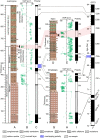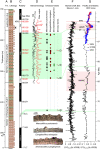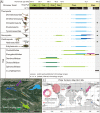Low dinosaur biodiversity in central China 2 million years prior to the end-Cretaceous mass extinction
- PMID: 36122246
- PMCID: PMC9522366
- DOI: 10.1073/pnas.2211234119
Low dinosaur biodiversity in central China 2 million years prior to the end-Cretaceous mass extinction
Abstract
Whether or not nonavian dinosaur biodiversity declined prior to the end-Cretaceous mass extinction remains controversial as the result of sampling biases in the fossil record, differences in the analytical approaches used, and the rarity of high-precision geochronological dating of dinosaur fossils. Using magnetostratigraphy, cyclostratigraphy, and biostratigraphy, we establish a high-resolution geochronological framework for the fossil-rich Late Cretaceous sedimentary sequence in the Shanyang Basin of central China. We have found only three dinosaurian eggshell taxa (Macroolithus yaotunensis, Elongatoolithus elongatus, and Stromatoolithus pinglingensis) representing two clades (Oviraptoridae and Hadrosauridae) in sediments deposited between ∼68.2 and ∼66.4 million y ago, indicating sustained low dinosaur biodiversity, and that assessment is consistent with the known skeletal remains in the Shanyang and surrounding basins of central China. Along with the dinosaur eggshell records from eastern and southern China, we find a decline in dinosaur biodiversity from the Campanian to the Maastrichtian. Our results support a long-term decline in global dinosaur biodiversity prior to 66 million y ago, which likely set the stage for the end-Cretaceous nonavian dinosaur mass extinction.
Keywords: dinosaur eggshells; east Asia; end-Cretaceous mass extinction; magnetostratigraphy.
Conflict of interest statement
The authors declare no competing interest.
Figures






References
-
- Schulte P., et al. , The Chicxulub asteroid impact and mass extinction at the Cretaceous-Paleogene boundary. Science 327, 1214–1218 (2010). - PubMed
Publication types
MeSH terms
LinkOut - more resources
Full Text Sources

